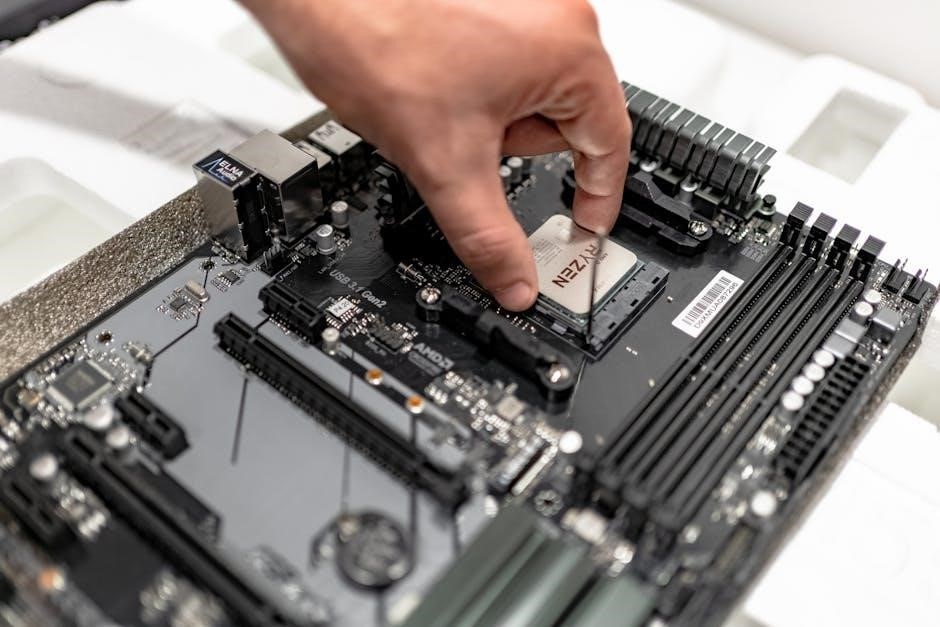Welcome to the Orbit 57946 manual, a comprehensive guide for installing, programming, and troubleshooting your smart irrigation controller. It ensures optimal performance and smart watering management.
Overview of the Orbit 57946 Model
The Orbit 57946 is a smart, 6-zone indoor/outdoor irrigation controller designed for efficient watering management. It combines advanced features like smart watering technology and weather-based adjustments to optimize water usage. Compatible with the B-hyve app, it allows remote scheduling and monitoring via Wi-Fi. The controller supports up to six zones, making it ideal for various lawn and garden configurations. Its user-friendly interface and app integration ensure seamless control, while energy-efficient design reduces power consumption. The Orbit 57946 is a versatile solution for homeowners seeking to balance convenience, conservation, and smart home integration. The manual provides detailed guidance for installation, programming, and troubleshooting to maximize its potential.
Importance of the Orbit 57946 Manual

The Orbit 57946 manual is essential for maximizing the potential of your smart irrigation controller. It provides clear instructions for installation, programming, and troubleshooting, ensuring proper setup and operation. The manual details how to connect the device to Wi-Fi, program watering schedules, and customize zones for efficient water use. It also offers guidance on using the B-hyve app for remote management and smart adjustments. Troubleshooting sections help resolve common issues like connectivity problems or zone malfunctions. By following the manual, users can optimize their sprinkler system’s performance, reduce water waste, and maintain a healthy lawn. It serves as a vital resource for both new and experienced users, ensuring seamless functionality and long-term system reliability.

Installation and Setup
The Orbit 57946 setup is streamlined for ease, guiding users through unboxing, mounting, and connecting to Wi-Fi, ensuring a smooth start for efficient irrigation management.
Unboxing and Initial Setup
Begin by carefully unboxing the Orbit 57946 controller and verifying all components are included. Place the device in a convenient location, ensuring easy access. Plug the controller into a power source and turn it on. The display will light up, prompting you to start the initial setup process. Follow the on-screen instructions to set your location, time zone, and other basic preferences. This step is crucial for ensuring proper functionality and connectivity. Once completed, you can proceed to connect the device to your Wi-Fi network and pair it with the B-hyve app for advanced features and remote control.
Mounting the Controller
Mounting the Orbit 57946 controller securely is essential for reliable operation. Choose a location protected from direct sunlight and moisture, ideally near a power source. Remove the controller from the wall plate by sliding it off, then attach the wall plate to a sturdy surface using screws. Reattach the controller to the wall plate, ensuring it is level. Connect all wires to their respective terminals, double-checking for proper connections. Finally, plug in the power cord and ensure the device is accessible for future maintenance. Proper mounting ensures durability and ease of use, while keeping the unit safe from environmental factors.
Connecting the Device to Wi-Fi
To connect your Orbit 57946 controller to Wi-Fi, start by opening the B-hyve app and selecting “Add Device.” Ensure your controller is in pairing mode, which can be activated by resetting it or following in-app instructions. Select your home Wi-Fi network from the list, enter your password, and wait for the device to connect. The app will guide you through the pairing process. Once connected, a confirmation message will appear. If you encounter issues, ensure your Wi-Fi signal is strong, and the password is entered correctly. Restarting the router or device may resolve connectivity problems. A successful connection allows remote management and smart features via the app.
Wiring the Sprinkler System
Wiring your Orbit 57946 sprinkler system involves connecting the controller to your sprinkler zones and power source. Start by turning off the power supply to avoid electrical hazards. Connect the common wire to the “COM” terminal and zone wires to their respective terminals on the controller. Ensure all connections are secure and free from corrosion. Use a multimeter to verify continuity between the controller and solenoids. After wiring, turn the power back on and test each zone manually to confirm proper operation. Proper wiring ensures reliable performance and prevents system malfunctions. Refer to the manual for specific terminal assignments and safety precautions to complete the installation successfully.

Programming the Orbit 57946
Program the Orbit 57946 by setting the date/time, creating watering schedules, and assigning zones. Customize watering cycles and enable manual operation for flexibility and efficiency.
Setting the Date and Time
Setting the date and time on your Orbit 57946 is essential for accurate scheduling. Use the touchscreen interface to navigate to the settings menu and select “Date & Time.” Choose your time zone and enable daylight saving adjustments if applicable. Ensure the date is correctly formatted (MM/DD/YYYY) and the time is in 12-hour format. Save your settings to synchronize the controller with your schedule. For optimal performance, consider enabling automatic time updates via the B-hyve app, which syncs with your smartphone’s time. Accurate time settings prevent scheduling conflicts and ensure zones activate as programmed. Regularly verify the date and time, especially after power outages, to maintain reliable operation. This step is critical for efficient watering and smart adjustments based on local conditions.
Creating Watering Schedules
Creating watering schedules with the Orbit 57946 is straightforward and customizable. Use the controller or B-hyve app to define watering zones, set start times, and choose frequencies (daily, every few days, or weekly). Specify the duration for each zone based on plant type, soil, and climate. For flexibility, select specific days of the week or opt for odd/even date scheduling. Advanced options allow you to adjust watering percentages based on weather conditions. Smart scheduling ensures efficient water use while maintaining healthy plants. Save your schedule to apply it automatically, and use the app to make real-time adjustments. This feature helps optimize water conservation and ensures your lawn receives the right amount of moisture precisely when needed.
Assigning Zones and Customizing Watering
Assigning zones and customizing watering on the Orbit 57946 allows you to tailor water delivery to specific areas of your lawn. Each zone can be programmed with unique settings, such as water duration and frequency, based on soil type, plant species, and sun exposure. Use the controller or B-hyve app to assign zones and adjust watering preferences. You can also enable smart watering adjustments, which adapt schedules based on weather data. For added flexibility, customize start times and apply different settings to each zone. This feature ensures that every part of your lawn receives the right amount of water, optimizing both efficiency and plant health. Refer to the manual for detailed steps on zone customization and advanced settings.
Manual Operation of the Sprinkler System
The Orbit 57946 allows for manual operation, enabling you to control the sprinkler system directly from the timer without relying on the app. This feature is useful for quick adjustments or when Wi-Fi connectivity is unavailable. To operate manually, simply use the controller’s interface to start, stop, or pause watering. You can also adjust run times and select specific zones to water. Manual mode ensures flexibility, letting you override scheduled programs temporarily. Any changes made manually will sync with the app, maintaining consistency across all devices. This feature is ideal for immediate tweaks or troubleshooting, ensuring your lawn care routine remains uninterrupted. Refer to the manual for step-by-step guidance on manual operations.

Using the B-hyve App
The B-hyve app simplifies remote management of your Orbit 57946 sprinkler system, offering features like scheduling, zone control, and smart watering adjustments. It provides real-time monitoring and notifications.
Downloading and Installing the App
To begin using the B-hyve app with your Orbit 57946 controller, download and install the app from the Apple App Store or Google Play Store. Simply search for “B-hyve” and select the official Orbit app. Once downloaded, open the app and follow the prompts to create an account or log in if you already have one. The app is designed to be user-friendly, guiding you through the setup process step-by-step. After installation, you’ll gain access to remote management of your sprinkler system, including scheduling, zone control, and smart watering features. The app also offers helpful tutorials and FAQs to assist with any questions during setup or use.
Pairing the Controller with the App
To pair the Orbit 57946 controller with the B-hyve app, open the app and log in to your account. The app will automatically search for nearby devices. Ensure your controller is in pairing mode, which may require a factory reset or pressing a specific button (refer to your manual for exact steps). Once detected, select the controller from the list in the app. You may be prompted to connect to the controller’s Wi-Fi network temporarily. After pairing, the app will guide you to connect the controller to your home Wi-Fi network. Once connected, you can manage your sprinkler system remotely, schedule waterings, and access smart features.
Remote Management of Watering Schedules
The B-hyve app allows you to remotely manage and adjust your watering schedules from anywhere using your smartphone or tablet. With the app, you can create, edit, or cancel watering schedules, ensuring your lawn receives the right amount of water at the right time. The app also provides real-time updates, enabling you to monitor your sprinkler system’s activity and make changes instantly. This feature is particularly useful for adjusting schedules based on weather conditions or unexpected water usage needs. The remote management capability simplifies lawn care by giving you full control over your irrigation system, even when you’re not at home.
Smart Watering Adjustments
The Orbit 57946 controller offers advanced smart watering adjustments, adapting to weather conditions, soil type, and plant needs for optimal irrigation. It integrates local weather data to automatically skip watering during rain or high wind, ensuring water is used efficiently. The system also allows manual adjustments through the B-hyve app, enabling users to fine-tune schedules based on specific lawn conditions. Customizable settings include watering duration, frequency, and start times, providing flexibility to suit different landscapes. These smart adjustments not only conserve water but also promote healthy plant growth by delivering the right amount of moisture when needed. This feature enhances the overall efficiency and effectiveness of your irrigation system.
App Notifications and Alerts
The Orbit 57946 controller, through the B-hyve app, provides essential notifications and alerts to keep you informed about your sprinkler system’s status. These alerts include low battery warnings, Wi-Fi connectivity issues, and system errors, ensuring you address problems promptly. The app also notifies you of completed watering cycles, scheduled adjustments, and weather-based modifications. Customizable alerts allow you to stay updated on specific events, such as zone malfunctions or extreme weather conditions affecting your watering schedule. These notifications enhance system reliability and help maintain optimal watering performance. By keeping you informed, the app ensures your lawn receives the right care while minimizing water waste and system downtime.

Troubleshooting Common Issues
Troubleshooting the Orbit 57946 involves addressing common issues like Wi-Fi connectivity problems, zone malfunctions, and display errors. Use error codes and reset options to resolve and optimize performance quickly.

Wi-Fi Connectivity Problems
Wi-Fi connectivity issues with the Orbit 57946 can often be resolved by restarting the device or checking your network settings. Ensure your router broadcasts a 2.4GHz network, as the controller does not support 5GHz. If the app cannot detect the device, reset the controller and re-pair it through the B-hyve app. Verify that the network name starts with “BHyve” during pairing. Additionally, ensure your smartphone and controller are updated to the latest firmware. If problems persist, check for physical obstructions between the controller and router or consult the manual for advanced troubleshooting steps. For further assistance, refer to the Orbit support page or contact customer service.
Zone Malfunction and Error Codes
If a zone is not functioning properly, check the wiring connections and ensure they are secure. Verify that the solenoid is working and free from debris. If an error code appears, refer to the manual or app for specific solutions. Common issues include faulty solenoids, low water pressure, or incorrect zone assignments. Restarting the controller or resetting it to factory settings may resolve the issue. Error codes like “E1” or “E2” often indicate specific problems, such as communication errors or zone malfunctions. Use the B-hyve app to diagnose and address these issues. If problems persist, contact Orbit customer support for further assistance or repair options.
Display Issues and Resetting the Device
If the display is unresponsive or showing incorrect information, restart the controller by unplugging it and waiting 30 seconds before plugging it back in. For a factory reset, press and hold the “Reset” button located on the back while powering on. This will restore default settings, so you’ll need to reconfigure your watering schedules. If the display remains dim or blank, check the power supply or replace the batteries if applicable. Ensure the controller is updated with the latest firmware to prevent software-related issues. If problems persist, contact Orbit support for further troubleshooting or potential replacement options.

Maintenance and Care
Regular maintenance ensures optimal performance. Clean filters, inspect wiring, and winterize the system to prevent damage. Replace batteries and update firmware as needed for smooth operation.
Regular System Checks
Regular system checks are essential to ensure your Orbit 57946 operates efficiently. Start by inspecting the timer for any display issues or software updates. Check all wiring connections to prevent malfunctions. Clean or replace filters to maintain water flow and system performance. Test each zone manually to confirm proper sprinkler activation. Verify Wi-Fi connectivity to ensure app functionality. Inspect outdoor components for damage or blockages. Review watering schedules to align with seasonal changes. Refer to the manual for detailed steps to perform these checks effectively. Regular maintenance helps prevent issues and extends the lifespan of your system, ensuring reliable performance year-round.
Winterization of the Sprinkler System
Winterizing your Orbit 57946 sprinkler system is crucial to protect it from freezing temperatures. Start by draining the entire system to prevent water from freezing and causing damage. Insulate exposed pipes and the controller to shield them from cold snaps. Set the timer to “rain mode” to disable watering without losing your programmed schedules. Disconnect and drain outdoor hoses to avoid ice formation. Consider blowing out the system with compressed air for thorough drainage. Store hoses and sensors in a protected area during harsh winter months. Refer to the manual for specific winterization steps tailored to your system. Proper winter care ensures your sprinkler system remains functional and ready for spring.
Cleaning and Replacing Filters
Cleaning and replacing filters is essential for maintaining the efficiency and performance of your Orbit 57946 sprinkler system. Regularly inspect the filters to ensure they are free from debris and sediment. To clean, remove the filters, rinse them with water, and let them dry completely before reinstalling. If filters are damaged or heavily clogged, replace them with new ones to prevent water flow issues. Refer to your manual for specific instructions on locating and accessing the filters. Proper maintenance helps extend the lifespan of your system and ensures consistent watering performance throughout the year. Always follow the manufacturer’s guidelines for replacement intervals and cleaning methods.
Battery Replacement and Power Management
The Orbit 57946 controller operates on a long-lasting battery, ensuring reliable performance. To replace the battery, locate the compartment on the back of the device, remove the old battery, and insert a new one of the same type. Proper power management is crucial for maintaining functionality. The controller features low-battery alerts to notify you when replacement is needed. During power outages, the system retains its programming, ensuring uninterrupted operation once power is restored. Regularly check the battery level and replace it as recommended to avoid system downtime. Always use high-quality batteries to maintain optimal performance and extend the lifespan of your controller.

Advanced Features
The Orbit 57946 features smart watering technology, weather-based adjustments, and integration with smart home systems. It also allows remote management through the B-hyve app for enhanced convenience.
Smart Watering Technology
The Orbit 57946 incorporates advanced smart watering technology that adjusts irrigation schedules based on real-time weather conditions, soil moisture, and plant needs. This system ensures efficient water use while maintaining healthy vegetation. The controller uses sensors and data from the B-hyve app to optimize watering cycles, preventing overwatering and underwatering. It also allows for customizable settings to accommodate different lawn types and climates. With smart watering, users can save water and reduce utility bills while keeping their lawn lush and green. The technology integrates seamlessly with the app, providing remote monitoring and adjustments for a hassle-free experience. This feature is a key highlight of the Orbit 57946, making it a modern solution for lawn care.
Weather-Based Adjustments
The Orbit 57946 controller features weather-based adjustments, allowing it to adapt watering schedules according to real-time weather data. This ensures water is used efficiently by skipping irrigation during rain or excessive moisture. The system integrates with local weather forecasts and soil conditions to modify watering times and durations automatically. Users can set preferences for temperature thresholds, rainfall amounts, and wind speeds to further customize adjustments. The B-hyve app provides notifications when weather-related changes are made, offering transparency and control. This feature not only conserves water but also protects plants from overwatering during unfavorable conditions. It’s a key component of the Orbit 57946’s smart irrigation capabilities, enhancing both convenience and efficiency for users.
Integration with Other Smart Home Systems
The Orbit 57946 controller seamlessly integrates with popular smart home systems, enhancing your home automation experience. It is compatible with Amazon Alexa and Google Home Assistant, allowing voice control of your irrigation system. Through the B-hyve app, you can pair the controller with other smart devices, creating a unified smart home ecosystem. This integration enables advanced automation, such as triggering watering schedules based on weather data or syncing with outdoor sensors. The system also supports IFTTT (If This Then That) applets for customizable smart home routines. With these integrations, you can manage your sprinkler system alongside other smart devices, ensuring a fully connected and efficient home environment. This feature makes the Orbit 57946 a versatile addition to any smart home setup.

Technical Support and Resources
For technical support, visit www.orbitonline.com or call 1-800-488-6156. Access FAQs, user manuals, and firmware updates online for troubleshooting and maintenance assistance.
Contacting Orbit Customer Support
For assistance with your Orbit 57946, contact customer support at 1-800-488-6156 or 1-801-299-5555. Visit www.orbitonline.com for FAQs, manuals, and troubleshooting guides. The B-hyve app also offers helpful resources and videos. Support is available to address connectivity issues, programming, and general inquiries. Ensure optimal performance by utilizing these resources for troubleshooting and maintenance.
Online Resources and FAQs
The Orbit website and B-hyve app provide extensive online resources to help you navigate the Orbit 57946 manual and troubleshooting. Visit www.orbitonline.com for access to FAQs, detailed manuals, and instructional videos. The B-hyve app also features help screens and guides for setup, programming, and smart watering. These resources cover topics like Wi-Fi connectivity, zone customization, and error resolution. Additionally, the app offers step-by-step tutorials for pairing devices and managing schedules. Online FAQs address common issues, ensuring you can resolve problems efficiently. Utilize these tools to maximize your sprinkler system’s performance and simplify your lawn care routine.
Downloading the Latest Firmware
To ensure optimal performance, keep your Orbit 57946 controller updated with the latest firmware. Firmware updates enhance functionality, fix issues, and add new features. The B-hyve app typically handles updates automatically, but you can manually check for updates in the app settings. Open the app, navigate to the “Menu” or “Settings” section, and select “Check for Updates.” If an update is available, follow the on-screen instructions to download and install it. Ensure your device is connected to Wi-Fi during this process. Regular updates guarantee your sprinkler system operates efficiently and securely. Visit the Orbit website for additional guidance on firmware updates and troubleshooting.

























